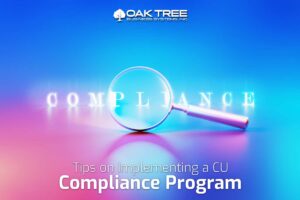
Navigating the Maze: How to Implement an Effective and Efficient Compliance Program for Your Credit Union
As a credit union executive, navigating the ever-evolving regulatory landscape can feel like tackling a complex maze. Implementing an effective and efficient compliance program is crucial for mitigating legal risks and fines and cultivating trust and transparency with your members. How do you create a program that balances comprehensiveness with practicality, without sacrificing valuable resources? Here are some tips on implementing a CU compliance program, which should help you get started or at least be a reminder of things you should address.
From Obligation to Opportunity
Shifting your mindset from viewing compliance as a burden to an opportunity for proactive risk management is key. A well-designed program fosters a culture of accountability and ethical conduct, ultimately strengthening your institution’s financial stability and reputation.
Building the Framework
Here’s a roadmap to guide you:
- 1. Assess Your Risk: Conduct a thorough risk assessment to identify areas of potential non-compliance based on regulations, your business model, and member demographics. Prioritize high-risk areas for focused attention.
- 2. Establish a Governance Structure: Designate a compliance officer or committee responsible for developing, implementing, and overseeing the program. Ensure clear reporting lines and communication channels throughout the organization.
- 3. Develop Comprehensive Policies and Procedures: Create clear, concise, and easily accessible policies and procedures that address identified risks and regulatory requirements. Regularly review and update these documents to reflect changes in regulations or your operations.
- 4. Embrace Training and Communication: Invest in ongoing training for all employees on relevant compliance topics. Foster a culture of open communication where employees feel empowered to report potential violations without fear of retaliation.
- 5. Leverage Technology: Utilize technology solutions to automate compliance tasks, streamline reporting processes, and enhance data analysis capabilities. This can improve efficiency and free up resources for higher-value activities.
- 6. Monitor and Measure Performance: Regularly monitor compliance activities, identify areas for improvement, and measure the effectiveness of your program. Utilize data analytics to track trends and proactively address potential issues before they escalate.
- 7. Stay Informed: Subscribe to industry publications and regulatory updates to stay abreast of changes in the landscape. Participate in professional associations and attend compliance-related conferences to gain insights and best practices.
Efficiency Hacks
Remember, efficiency is key. Here are some tips:
- Risk-based approach: Focus resources on high-risk areas, not low-risk activities.
- Streamlined processes: Automate tasks and utilize technology to reduce manual effort.
- Cross-departmental collaboration: Leverage existing resources and expertise across departments.
- Continuous improvement: Regularly review and adapt your program based on lessons learned and changing needs.
By implementing a comprehensive, yet efficient, compliance program, your credit union can navigate the regulatory maze with confidence. Remember, compliance isn’t just about avoiding penalties; it’s about safeguarding your institution’s future and building trust with your members. Take the reins, embrace the opportunity, and guide your credit union toward a brighter, more secure future. We are all about compliance because we know how important it is for us, for you, and your members. When you want the best complaint forms for your credit union you can request a free sample of our credit union documents.


